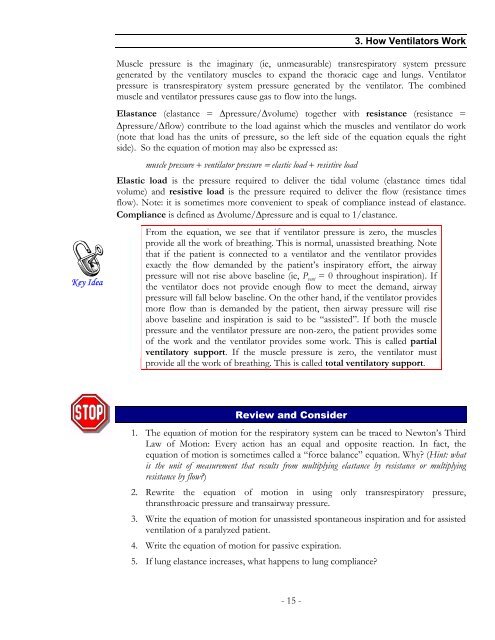Dräger Instructional CD: Mechanical Ventilation - VentWorld
Dräger Instructional CD: Mechanical Ventilation - VentWorld
Dräger Instructional CD: Mechanical Ventilation - VentWorld
Create successful ePaper yourself
Turn your PDF publications into a flip-book with our unique Google optimized e-Paper software.
Key Idea<br />
3. How Ventilators Work<br />
Muscle pressure is the imaginary (ie, unmeasurable) transrespiratory system pressure<br />
generated by the ventilatory muscles to expand the thoracic cage and lungs. Ventilator<br />
pressure is transrespiratory system pressure generated by the ventilator. The combined<br />
muscle and ventilator pressures cause gas to flow into the lungs.<br />
Elastance (elastance = ∆pressure/∆volume) together with resistance (resistance =<br />
∆pressure/∆flow) contribute to the load against which the muscles and ventilator do work<br />
(note that load has the units of pressure, so the left side of the equation equals the right<br />
side). So the equation of motion may also be expressed as:<br />
muscle pressure + ventilator pressure = elastic load + resistive load<br />
Elastic load is the pressure required to deliver the tidal volume (elastance times tidal<br />
volume) and resistive load is the pressure required to deliver the flow (resistance times<br />
flow). Note: it is sometimes more convenient to speak of compliance instead of elastance.<br />
Compliance is defined as ∆volume/∆pressure and is equal to 1/elastance.<br />
From the equation, we see that if ventilator pressure is zero, the muscles<br />
provide all the work of breathing. This is normal, unassisted breathing. Note<br />
that if the patient is connected to a ventilator and the ventilator provides<br />
exactly the flow demanded by the patient’s inspiratory effort, the airway<br />
pressure will not rise above baseline (ie, P vent = 0 throughout inspiration). If<br />
the ventilator does not provide enough flow to meet the demand, airway<br />
pressure will fall below baseline. On the other hand, if the ventilator provides<br />
more flow than is demanded by the patient, then airway pressure will rise<br />
above baseline and inspiration is said to be “assisted”. If both the muscle<br />
pressure and the ventilator pressure are non-zero, the patient provides some<br />
of the work and the ventilator provides some work. This is called partial<br />
ventilatory support. If the muscle pressure is zero, the ventilator must<br />
provide all the work of breathing. This is called total ventilatory support.<br />
Review and Consider<br />
1. The equation of motion for the respiratory system can be traced to Newton’s Third<br />
Law of Motion: Every action has an equal and opposite reaction. In fact, the<br />
equation of motion is sometimes called a “force balance” equation. Why? (Hint: what<br />
is the unit of measurement that results from multiplying elastance by resistance or multiplying<br />
resistance by flow?)<br />
2. Rewrite the equation of motion in using only transrespiratory pressure,<br />
thransthroacic pressure and transairway pressure.<br />
3. Write the equation of motion for unassisted spontaneous inspiration and for assisted<br />
ventilation of a paralyzed patient.<br />
4. Write the equation of motion for passive expiration.<br />
5. If lung elastance increases, what happens to lung compliance?<br />
- 15 -


